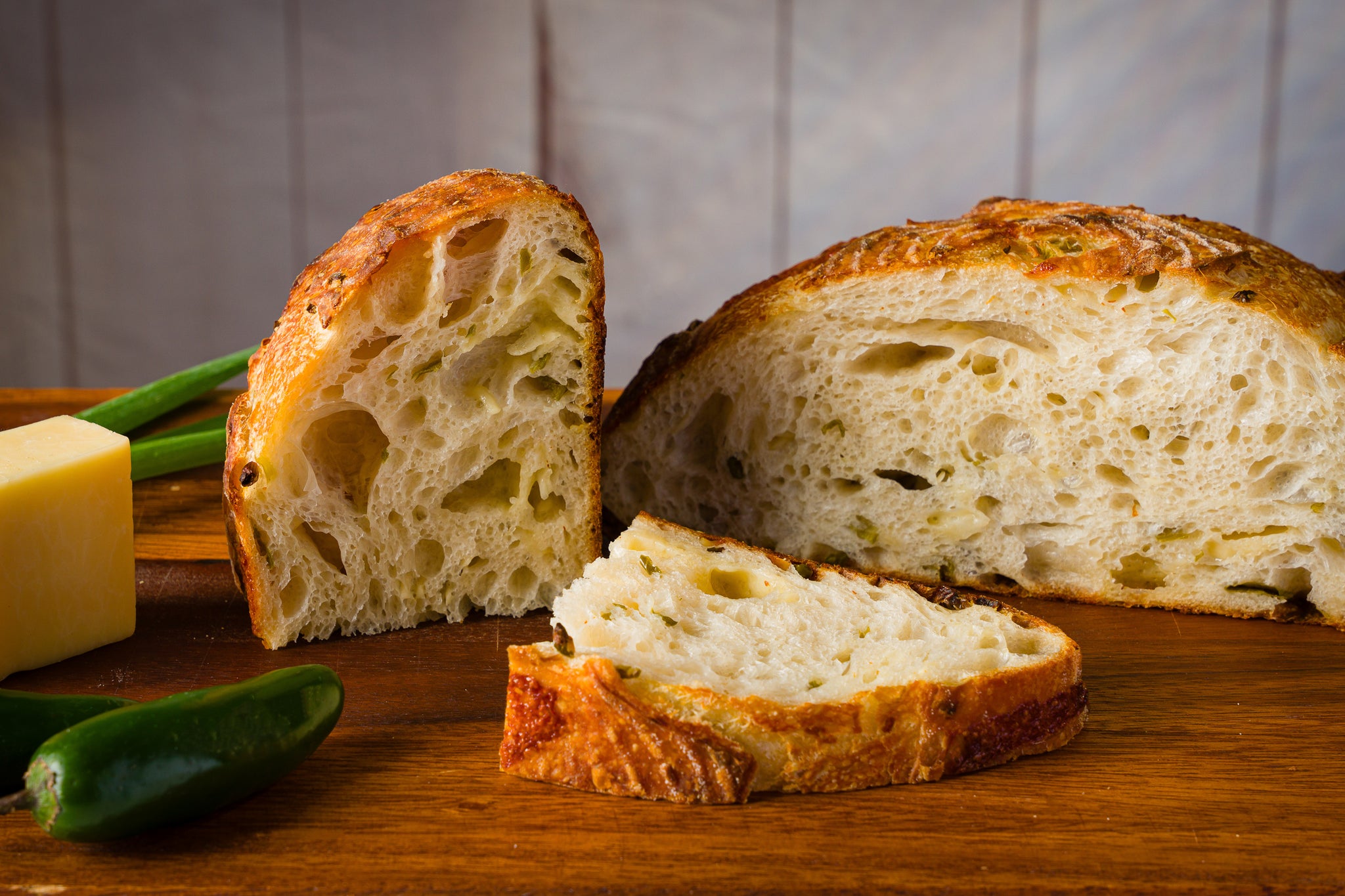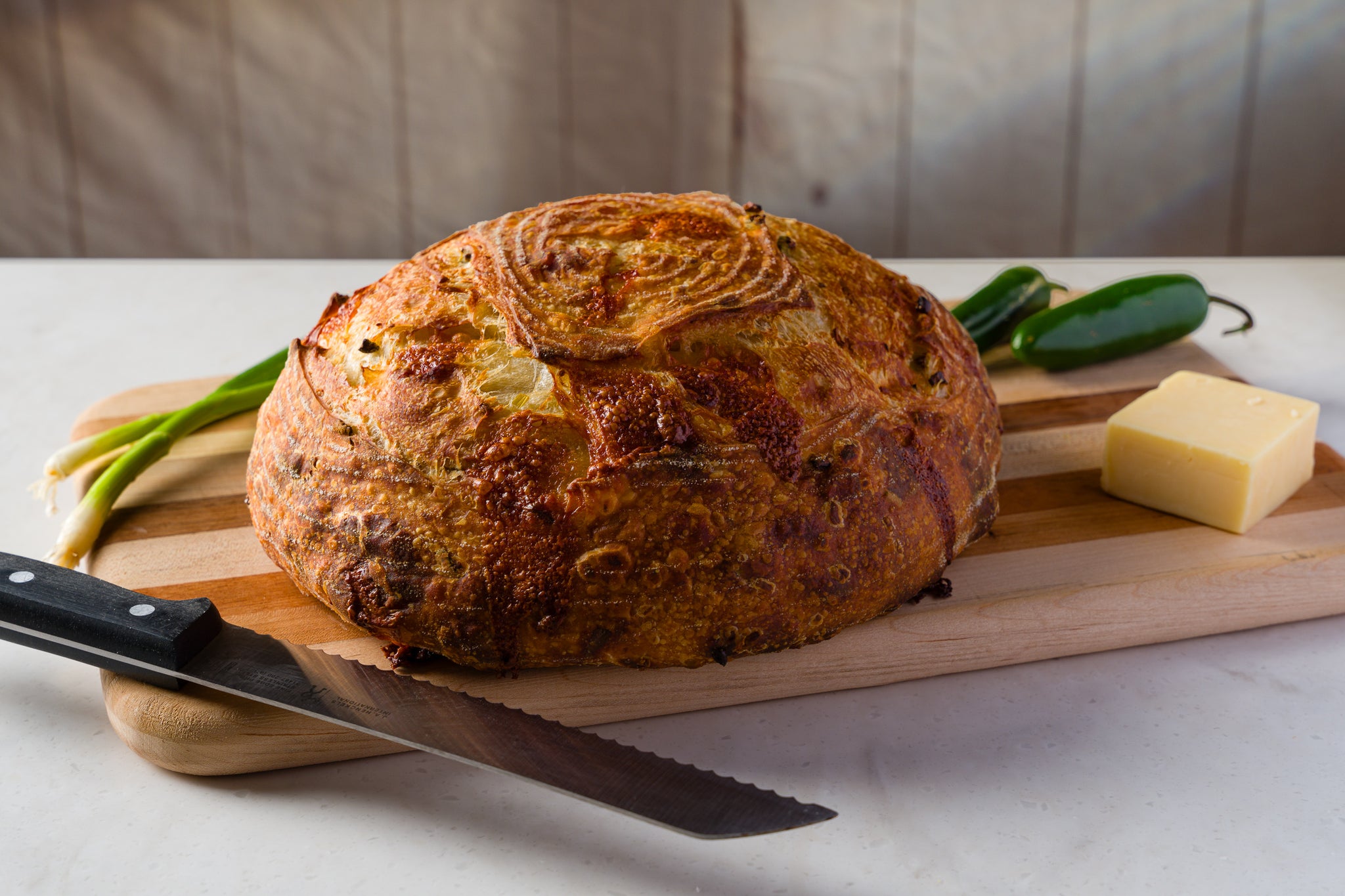

Cheddar Jalapeno Scallion Sourdough
We are not exaggerating when we say this loaf has an irresistible aroma that will draw everyone into the kitchen.
This loaf is the perfect blend of savory flavors, combining the sharpness of cheddar, the gentle heat of jalapenos, and the fresh kick of scallions. Despite the boldness of jalapenos, this bread maintains a pleasing mildness, appealing to both the adventurous and the cautious. Customize the flavor to your liking by adjusting the number of jalapenos– one for a subtler flavor or two for that extra kick.
Sharp cheddar really shines here. We used a block and worked it into the dough in two ways: grated and cubed. The grated cheese seamlessly melds into the dough during baking, infusing every bite with its rich taste. The cubed cheese, on the other hand, creates delightful pockets of melted goodness, adding a luxurious texture to your loaf. Whether you prefer one method or a combination of both, this recipe offers the flexibility to make it your own.
Prep
30 hours
Cook
40 minutes
Total
31 hours
Yield
One loaf


Ingredients
- 450g (3 ¾ C) Bread flour
- 90g (about ½ C) Ripe sourdough starter
- 340g (1 ½ C) Water, divided
- 9g (1 ¾ tsp) Salt
- 1 to 2 Jalapenos, seeded and diced
- 75g diced Cheddar cheese
- 50g grated Cheddar cheese
- 35g (about 2) Scallions chopped
Instructions
- Set up the Proofer: Set the Proofer to 79°F (26°C) and put the water tray in the middle of the warming plate. Pour ¼ cup (60 ml) of water into the tray and place the rack on top of the tray.
- Autolyse: In a mixing bowl, add 325g of warm water (approximately 85°F / 30°C), reserving 15g for later. Mix in all the flour using a dough whisk or your hands until no dry flour remains. Cover and let the dough rest for 30 to 60 minutes in the Proofer. This rest period helps the flour fully hydrate and begins gluten development.
- Mix the dough: Remove the dough from the Proofer. Remove the dough from the Proofer. Incorporate the salt, the starter, and the reserved 15g of water. Mix with the dough whisk or by hand until well combined. Then fold the dough by picking up one side of it, stretching it, and bringing it toward the center. Rotate the bowl and repeat this folding motion about 20 more times until the dough begins to strengthen and show some resistance.
- Bulk fermentation: (Bulk fermentation will take about 5 hours in total. During the first 2 hours, folds will be performed, and the cheese, peppers, and scallions will be added.) Return the dough to the Folding Proofer and set a timer for 30 minutes. When the timer goes off, perform the first set of stretch and folds. To perform a set of stretch and folds: With the dough still inside the bowl, pick up one edge of the dough, stretch it as far as it will go, and then fold it into the center. Turn the bowl 90 degrees and repeat the stretch and fold motion. Repeat this motion until you have gone around the circumference of the bow two times and the dough begins to feel less slack and resist stretching. Place the dough back into the Proofer and let the dough rest for another 30 minutes.
- To laminate the inclusions: Dampen the countertop lightly to prevent the dough from sticking. Turn the dough out and stretch gently to form a large, thin rectangle. Evenly distribute the cheddar, peppers, and scallions over the dough. Take one side of the dough and fold it in toward the center. Repeat on the opposite side, folding on top of the first fold. Next, roll up the dough to create a round shape. Place the dough back in the bowl and return it to the Proofer. Over the next hour, perform two more sets of stretch and folds 30 minutes apart. After the last fold, leave the dough to rest in the Proofer for the remainder of the bulk fermentation time. When the bulk fermentation is done, the dough will have increased in volume by 50%, will feel light to the touch, and should jiggle if the bowl is shaken. If the dough still feels dense, allow it to rise a little longer.
- Shape: Remove the dough from the Proofer and turn it onto a floured counter to shape it into a round boule. Start shaping by stretching the bottom edge of the dough outward and folding it over to the center. Repeat this with the right and left sides, and finally, stretch the top of the dough and fold it towards the center to form a rough rectangular shape. Next, using a bench knife, carefully flip the dough over so the seam side is now on the counter. Cup the edges of the dough with your hands and gently pull the dough towards you, tucking it under itself while dragging it across the counter to build surface tension. Rotate and repeat this motion to form an even round shape. Use the bench knife to lift the dough and place it seam side up in a 9-inch round banneton dusted with flour. If the bottom seam is not fully sealed, pinch it gently but firmly to close, ensuring the dough maintains its shape and tension as it rests overnight.
- Refrigerate overnight: Cover the banneton and place it in the refrigerator until the next day (or up to 24 hours later).
- Bake: The next day, place a Dutch oven inside the oven and preheat to 450°F (232°C) for about 30 to 40 minutes. Remove one loaf from the refrigerator. Turn the dough out onto a piece of parchment paper and score the dough. Remove the Dutch oven from the oven, use the parchment paper to transfer the dough into the baking vessel, cover with the lid, and place back into the oven. Bake for 20 minutes. Remove the lid, lower the temperature to 425°F (218°C), and continue baking for another 18 to 20 minutes with the lid off. Remove from the oven and place loaf on a rack to cool.















